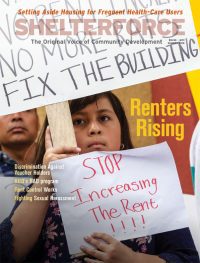
Photo credit: JK B via flickr, CC BY-SA 2.0.
The housing world is still talking about a recently published study: a former Goldman Sachs asset manager and a former UBS investment banker, both assistant professors at Stanford University’s School of Business, have concluded that rent control—not the blatant abuse of industry-created loopholes around it—fueled San Francisco’s rising rents and gentrification.
The Stanford paper, The Effects of Rent Control Expansion on Tenants, Landlords and Inequality: Evidence from San Francisco, is part hard data, part flawed methodology, and part misguided editorializing. While the data portion of the report documents the direct and substantial benefits of rent control in achieving its purposes, the balance of the paper uses flawed assumptions and conjecture to conclude that the direct, proven benefits of rent control are somehow negated by indirect effects. The result is a paper that is at best ill-informed and at worst flat-out biased.
Data Shows the Effectiveness of Rent Control
Most press coverage of the study has ignored its findings regarding the direct benefits of rent control. The data—before it is subject to the authors’ flawed assumptions—makes a compelling case for the effectiveness of rent control in stabilizing tenant homes, providing further evidence of what advocates have long known: Rent control is an essential policy to prevent the displacement of working-class tenants, seniors, immigrants, and communities of color from hot urban real estate markets.
The Stanford paper fully supports the conclusion that rent control works to keep people in their homes: “We find that rent control increased the probability a renter stayed at their address by close to 20 percent.” The stabilizing effects are “significantly stronger among older households and among households that have already spent a number of years at their treated address.” In other words, seniors and long-term tenants find longer-term stability because of rent control.
Equally importantly, the study confirms how rent control prevents displacement from the city. “We can see that tenants who receive rent control protections are persistently more likely to remain at their 1993 address relative to the control group. Not only that, but they are also more likely to be living in San Francisco.”
The paper also acknowledges the substantial financial benefit conferred on tenants because of the expansion of rent control in San Francisco in 1994. “Across the entire population, the aggregate benefit was $7.085 billion dollars, reflecting an annual average of $394 million dollars. Note also that these welfare numbers are only for the 1994 population impacted by the rent control expansion. It does not take into account the welfare benefits for renters who moved into the impacted properties in later years, which presumably were also quite large.”
The $7 billion savings for tenants is the tip of the iceberg, relating only to the studied group—tenants in small buildings who lived in their homes in 1994 when they became rent controlled. As the authors note, it does not measure the benefit for all of the tenants who moved into the studied properties after they gained rent control.
Meanwhile, landlords were not exactly scraping to get by. They enjoyed the significant appreciation of their properties and rising rental income thanks to government policy designed to maximize landlord profits (Prop. 13 kept their taxes low; Costa-Hawkins kept their rents high.) With landlords continuing to thrive while tenants saved money and realized greater housing and community stability, one would expect some comments about how rent control has been a wildly successful program.
The Stanford authors, however, were not content to recognize these successes of the 1994 expansion. They have a different story to tell, with flawed assumptions aplenty.
A Fundamentally Flawed Critique
Here is the Stanford study’s argument in a nutshell: a) Newly covered rent-controlled units are more likely to be converted than non-rent controlled units, b) The decrease in supply of rental units from conversion causes rising rents citywide, and c) This aggregate citywide increase in rents outweighed the economic benefits of rent control in the newly covered units.
The study makes three critical mistakes:
Mistake #1: The authors blame rent control, rather than speculator creation and abuse of loopholes around rent control, for the displacement of tenants.
That is a political choice, not an academic one. According to the Stanford study, 15 percent of the units in certain smaller buildings in San Francisco have been “converted” to market rate since voters placed these buildings under the city’s rent control law through a 1994 ballot measure. That unremarkable finding simply highlights what tenant advocates have been trying to stop for years—speculation that skirts rent control by converting units.
It is fairly obvious that regulating a good or service creates an incentive for the seller of that good or service to try to avoid the regulation. Indeed, the authors “find that the owners of exogenously rent controlled properties substitute toward other types of real estate that are not regulated by rent control.” However, the authors act as if legislators were powerless to plug up loopholes that allowed conversion of rent-controlled housing.
So-called “tenancies-in-common” were brought to San Francisco by real estate profiteers who sought to buy and sell apartments, but could not condo convert more than 200 rental apartments a year because of the city’s visionary Condominium Conversion ordinance passed in the 1980s. So, speculators created condo-like entities, called TICs, hoping they were legally different enough to be outside the condo conversion law. Efforts to regulate TICs as condos did not succeed.
Had this loophole been plugged, the unit conversions of which the authors complain would not have been possible, and most of the subject units would still be affordable, rent-controlled units. Likewise, with sensible amendments to the Ellis Act, mass evictions from these buildings would not have been legal or profitable.
The following is perhaps the most off-base assumption in the entire paper. It stems from an assumption that evictions are a given, and in fact are an acceptable way for landlords to avoid rent control, rather than a form of speculator abuse that needs to be stopped. The authors write:
“In practice, landlords have a few possible ways of removing tenants. First, landlords could move into the property themselves, known as move-in eviction. The Ellis Act also allow landlords to evict tenants if they intend to remove the property from the rental market—for instance, in order to convert the units to condos. Finally, landlords are legally allowed to offer their tenants monetary compensation for leaving. In practice, these transfer payments from landlords are quite common and can be quite large. Moreover, consistent with the empirical evidence, it seems likely that landlords would be most successful at removing tenants with the least built-up neighborhood capital, i.e. those tenants who have not lived in the neighborhood for long.”
The authors refuse to entertain the possibility that rent control is not functioning fully due to loopholes, without which these landlords would have had not few, but no “ways of removing tenants” for speculative gain. It is worth noting that all rent control laws, including San Francisco’s, already allow landlords to evict tenants who fail to pay rent or otherwise violate terms of their leases, as well as allowing “owner move-in” evictions where landlords seek to move into the home. What is at issue here, and the authors seem fine with, is the idea that landlords should have even more ways to evict tenants for speculative gain amidst a housing crisis.
Speculators are making a killing through evictions and conversions, while spinning a narrative of blaming rent control instead of those who are abusing it. That’s understandable for speculators, but these professors should know better. The article’s insistence on characterizing landlords as victims who reasonably sought conversion to avoid the burdens of rent control dovetails with boilerplate real estate industry spin. The reality is that conversions were driven by the greed of real estate speculators who were willing to do anything to “reposition” the properties for greater profit.
Mistake #2: The authors’ causation analysis ignores other important causes of citywide rents rising.
The authors blame rising rents citywide on the existence of rent control. “We find losses to all renters of $5 billion due to rent control’s effect on decreasing the rental housing and raising market rents.” Here is the entire analysis of their assumption that the loss of 15 percent of the newly covered units is responsible for the rising market rents:
“We finally turn to evaluating the GE welfare impact of the landlord supply response. Intuitively, since landlords reduced supply in response to the 1994 law, as was shown in Section 4.2, average San Francisco rents were higher than they otherwise would have been.”
There is nothing intuitive about this, yet this assumption is the key to their whole analysis. Without it, the supposed “welfare losses” from rent control crumble.
Rents rise for many reasons , but rent control is not one of them. In fact, without rent control, cities like San Francisco would be almost exclusively for the rich.
Cambridge provides a clear case of what happens without rent control, and it’s no surprise: rents go up. When rent control was eliminated in Massachusetts, costs of all housing in Cambridge—formerly rent controlled and uncontrolled units—rose dramatically. (See Housing Market Spillovers: Evidence from the End of Rent Control in Cambridge, Massachusetts.) As Richard Arnott writes, rent stabilization like we have in California prevents rent-gouging and displacement and allows for a fair return on investments (Time for Revisionism on Rent Control?). And Eric Fischer’s recent analysis of San Francisco rents from 1950 to present day found that rent control did not increase rent overall.
The Stanford study argues that the 1994 expansion of rent control to small buildings in San Francisco led to the conversion of 15 percent of the newly rent-controlled units, which they cite as the cause of a 7 percent rent increase citywide resulting from reduced supply. The authors assume without analysis that the reduced supply (a tiny fraction of the city’s total rental stock) caused the citywide price increases. The authors also ignore other factors driving the increases, mainly surging demand for housing due to the region’s tech employment boom, the city’s refusal to enforce local laws against converting rental units to short term rentals like Airbnb, Wall Street’s securitization of rental income, and international real estate investment.
The authors also completely ignore that, were rent control allowed to fully operate, there would be limits on the allowable rent increases across the city through vacancy control. The absence of vacancy control creates the most obvious incentive for a landlord to evict a rent-controlled tenant from an existing unit, without ever having to initiate a conversion. Remarkably, the authors write an entire paper blaming rising rents on rent control, and do not even mention once that the primary tool that the city could use to prevent those citywide rent increases is vacancy control, which the real estate industry banned through statewide legislation in 1995.
Mistake #3: The methodology makes apples-to-oranges comparisons.
Even accepting the authors’ two flawed assumptions—that rent control is to blame for conversions and that the resulting supply reduction drove up rents citywide—there is a third fundamental problem with the analysis. Specifically, the authors wildly understate the economic benefits of rent control by making apples-to-oranges comparisons between tenant cohorts in their analysis.
In estimating what tenants save because of rent control, the study focused exclusively on tenants in the newly covered small buildings at the time of the rent control expansion in 1994. They compare the savings of that group with citywide rent increases of rents on all units for a decade. Omitted from the plus side of the equation are all beneficiaries of the newly covered units who moved in after 1994. In fact, most of the small buildings they studied remained rent-controlled throughout the studied period (85 percent of those units, if the study’s data is accurate), yet the benefits of rent control for those subsequent tenants are entirely omitted by the authors.
To be clear, for every year after 1994, tenants moved into rent controlled homes that would not have been rent controlled without the 1994 rent control expansion. Yet the rent control benefits of financial and communal stability for those tenants are excluded from the cost-benefit analysis. Had they been included, the benefits of the rent control expansion would dwarf the supposed, speculative harms.
Finally, while converted units no doubt contribute to gentrification, the authors ignore the gentrification that would have occurred if the ballot initiative had not expanded rent control to cover small buildings. Without the 1994 law that brought smaller, owner-occupied buildings under rent control, 15 percent of those units may not have been converted, but they would be renting at market rate, which in San Francisco is unaffordable to the working class. Without rent control on these units, 100 percent of the subject units would have rented at market rates that are exclusionary to seniors, working families, and many communities of color. By failing to factor in the accelerated gentrification that would have occurred but for rent control, the authors further undermine their own conclusions.
Rent Control Works
Supply-side economics will not solve the housing crisis. Evaluating rent control solely on changes in rental housing supply is myopic and does not answer the question of whether rent control works to protect our most vulnerable residents in a time of extreme income inequality. Landlords who have made the decision to evict rent-controlled tenants for profit do so not because of rent control itself, but because of available industry-created loopholes around rent control that allow evictions and create profit incentives. Left unregulated, speculators will create and exploit opportunities to evict longtime tenants, convert units to condos or vacation rentals, or rent to higher-paying tenants. There is a clear historical pattern of spikes in the eviction of rent-controlled tenants that do not correlate to the expansion of rent control itself, but in the overall volatility of the rental housing market.
What works best to drive down the cost of housing is heavy investment in affordable and public housing. A study by the UC Urban Displacement Project has found that affordable housing has twice the impact as market-rate development on preventing displacement.
This long-term strategy in no way suggests that housing on the private market should remain a windfall profit generator for landlords and real estate speculators. To the contrary, we must stop rent gouging and evictions of tenants in the private market as we build political momentum for increasing social housing.
These Stanford authors follow a long line of free-market academics who take no issue with the function of housing as a mere commodity and decry the “price distorting” impacts of rent control. Yet it is what these economists criticize as “price distortion” that others view as one of the few successful models of maintaining affordable housing and preventing displacement in booming real estate markets. Rent control would be even more successful in this regard if not unreasonably constrained and undermined by industry-written state laws that create loopholes for speculators.
Faulty studies like this are used as ammunition by the real estate industry, which are among the biggest lobbies in the state and the second-largest in America, to decimate protections for renters and destabilize the lives and livelihoods of low-income and working families. Findings that support rent control are ignored while the industry spends their tenants’ unfairly priced rents on unlimited resources to ensure that politicians and media outlets regurgitate even the most speculative and ill-informed rent-control critiques.
The industry and business school professors like these authors insist on elevating the narrative of “mom-and-pop” landlords as faux-victims, while ignoring the real estate speculators who are driving the housing crisis. The “mom-and-pop” landlords are, of course, guaranteed a fair return on their investment by law even in rent-regulating cities, and continue to make well above a fair return in San Francisco. Framing economic decisions through the plight of small landlords allows critics to question rent control without addressing the prevalence of corporate real estate speculation. There are, in fact, corporate real estate speculators in San Francisco that profit handsomely by converting rent-controlled properties to out-of-control profit centers like real estate investment trusts (REITs), and will continue to do so long as they are given free rein.
Meanwhile, tenants who make up nearly half of California’s population are left to work multiple jobs or suffer displacement to pay for the excesses of this industry. We hope that the next time a university of Stanford’s reputation examines rent control, the authors will center the social value of tenant and community stability and address the exploitative greed of the real estate industry that drives rents and displacement. If they do, they will recognize the success of rent control, which is thus far the only proven, immediate solution to rising rents and displacement in California cities.
A version of this article originally ran on Medium.com.






Please review the credibility of the authors prior to giving this op-ed any further thought.
Yes I am a landlord and would love rent control. I want to live in downtown Los Angeles for $800 a month in a sky rise. Can you make that happen? Or how about next to the beach? How are you going to regulate every part of housing to make it fair for everyone who wants to live next to the beach or downtown?
Ridiculous argument. Try again but this time with facts.
“We find that rent control increased the probability a renter stayed at their address by close to 20 percent.” Well of course somebody who is fortunate enough to have a rent controlled apartment is going to stay there. Rent Controlled tenants are paying below market prices on rent, why would they leave. “Rent stability” as at called is not desirable. What is desirable is the quantity and quality of housing, and rent control by forcing landlords to accept below market prices destroys incentives to build more housing and to repair existing rental housing.
What you’re saying about landlords not being motivated to do necessary repairs is totally untrue, Herp Derp. On the contrary, Rent Control motivates landlords to do the necessary repairs and whatever, in order to maintain and keep up their property. Rent Control also works, because it protects tenants against condo-related or retaliatory evictions, and prevents landlords from unnecessarily gouging tenants rent-wise.
This is not to say that landlords can’t get a raise in rents under rent control. If a landlord’s costs go up, for instance, then s/he can raise their rents accordingly, but they must go through Rent Control first. As far as condo-related evictions and retaliatory evictions go, under rent control, landlords cannot evict tenants just so they can convert their rental properties into condos. As for retaliatory evictions, landlords cannot evict tenants for lodging complaints about the lack of necessary repairs that should be made by landlords.
The polemical tone of the authors – “greed”, “rent gouging”, etc., – takes away from their credibility. If the tenants under rent control are benefiting by $7B then the landlords are not getting that $7B. That will affect their incentives to maintain rental units as rental units as prices rise and the opportunity cost of keeping them as rental units becomes greater and greater. It gets even worse if vacancy control is introduced.
One possible way to maintain economic diversity is to require all multi-family apartments – new or old – maintain a certain percentage for lower income people. Then there is every incentive to properly maintain existing apartments and still build more.
Dean Preston and Shanti Singh,
You made a good point about the benefits of rent control by citing, “We find that rent control increased the probability a renter stayed at their address by close to 20 percent.” I also understand what you said about tenants in San Francisco gaining $7 billion as a result of rent control. These are true, but you must understand that rent control also keeps people from moving to the city because they can’t find places to live because of the housing shortage it causes. Even though rent control decreases displacement, it does not increase the overall population if a city. Also, if renters are keeping $7 billion, that means landlords aren’t getting those $7 billion. This does not help the overall economy of the city. So, the points made in this article to support rent control are actually mute points that neither support nor oppose the policy.
Best,
Chris Gilbert
The “former UBS investment banker” was a summer analyst there for 3 months. The former “Goldman Sachs asset manager” worked there for 13 months as an analyst in quant strategies fresh from college.
Also the authors of this post neglect to mention the paper was actually written by three authors, the last of whom never worked in finance.
This is the dumbest article of all time. There is a reason why it’s almost a unanimous vote by economists that rent control does more harm than good.
WOW! As someone who spent MORE THAN 30 YEARS as a tenant and also as a mom and pop landlord of a mere 4 apartment units (after much hard work!) more recently, I REALLY REALLY wanted to have some sympathy with your argument but I can’t. I just can’t. Your argument is unfair, biased and ignorant. Stating that “mom and pop landlords are guaranteed a fair return on investment”??? I have NEVER IN MY LIFE HEARD A MORE INSULTING AND LUDICROUS STATEMENT. Covid-19 is causing my husband and I to lose our retirement investment which is what our tiny building is for us. We had to put up with a 25% loss of income when one of our tenants lost their jobs. As empathetic as I am to that when I tried to work with them, the avoided me at every turn and refused to sit down and talk like mature adults. I am on disability due to a work injury and my husband is over 65 and on Social Security so where is the empathy for us huh? We WORKED HARD all of our lives for this and my husband saved in ways that more people should,, myself included but some of you are kinda fanatical and seem to think “all” landlords are “rich” and morally suspect. We are not. We treat our tenants with kindness and respect but I can’t say we get the same treatment from every tenant. Some of them, like the one’s who owed us rent, act like children who have to be chased down to behave responsibly. The thing is,if they had just come to us sooner and been honest about their situation instead of acting with hostility and childishness, we would have written out a contract on how to pay back their rent and heck, I even offered them work at $20 per hour that I needed to have done to pay back the back rent but these people were too good to work with me. I would have even offered them letters of recommendation too. So, when you say bad stuff about landlords, you need to be cognizant that we’re human beings and stop painting all of us with the same black brush. I tend to agree that there are bad ones out there but there are good ones too and you need to remember that and stop treating us as all “evil”.